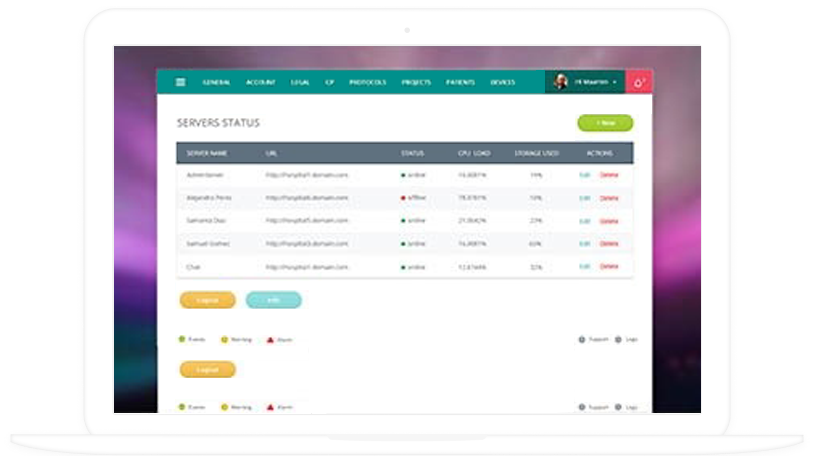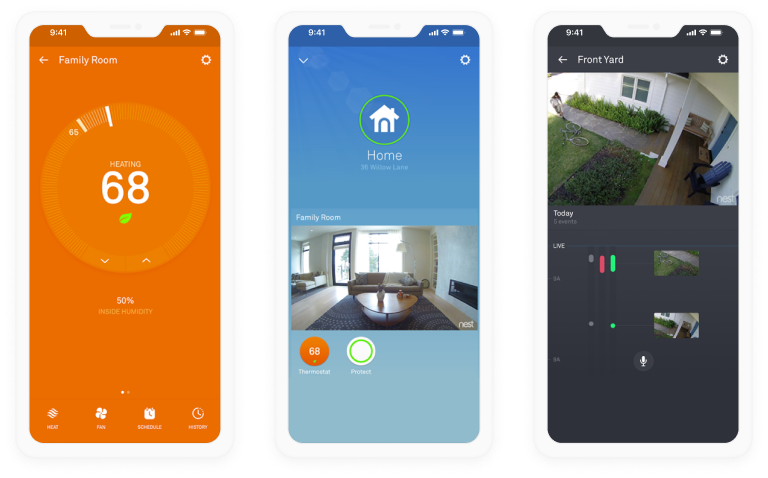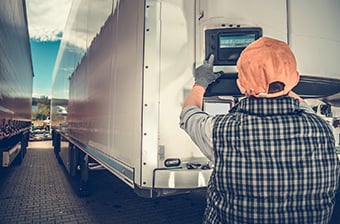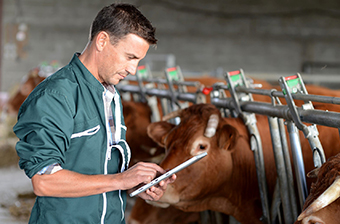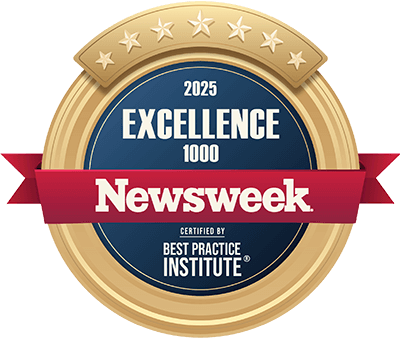IoT Application Development Services
Over 14 years in IoT software development
IoT software development services cover requirements engineering, architecture design, platform and user apps creation, testing, and support. ScienceSoft offers IoT development services to deliver robust IoT solutions that optimize business processes and improve work safety.
Types of IoT Solutions We Deliver
ScienceSoft delivers Internet of Things solutions of any complexity for varied use cases in 30+ industries.
Industry-specific
Manufacturing
- Smart factory.
- Inventory tracking.
- Machine monitoring.
- Equipment monitoring.
- Equipment management.
- Overall Equipment Effectiveness tracking.
- Condition monitoring.
- Employee health and safety monitoring.
- Product quality management.
Healthcare
- Hospital asset tracking.
- Medical staff and patient location tracking.
- Remote patient monitoring and diagnostics via smart medical devices.
- Smart lighting in hospitals.
- Automated hospital climate control.
- Smart home care (e.g., fall detection, sleep rhythm tracking, air quality monitoring).
Oil and Gas
- Monitoring storage conditions of oil and gas.
- Pipeline surveillance and leakage detection.
- Remote oil & gas equipment inspection.
- Predictive maintenance of oil & gas equipment.
Energy
- Home/enterprise energy management.
- Energy consumption analytics.
- Energy forecasting.
- Asset management.
- Energy billing optimization.
- Utility communication.
Agriculture
- Smart greenhouses, farms.
- Real-time tracking of soil, water, light, humidity, temperature conditions.
- Analysis of crop data.
- Predicting weather patterns.
- Tracking supply chains of agricultural products.
Retail
- Beacon-enabled loyalty programs for personalized in-store customer experience.
- Smart shelves tracking product stock and scheduling replenishment.
- Traffic control to restrict the number of in-store visitors.
Construction
- Equipment and vehicle location tracking.
- Real-time monitoring of construction equipment data and condition.
- Employee health and safety tracking via wearables.
Cross-industry Internet of Things solutions
Predictive maintenance
- Remote monitoring of products / equipment performance.
- Early detection of problems.
- Uncovering failure patterns.
- Validating warranty claims.
- Identifying warranty violations.
Supply chain management
- Monitoring of inventory levels.
- Automated alerting on low stock.
- Warehouse climate control.
- Robotic order fulfillment.
- Transportation climate control.
Real-time asset tracking
- Asset location and movement tracking (both indoors and outdoors) with interactive maps and geofencing.
- Asset tracking analytics and reporting.
Connected products
- Smart industrial products with control apps.
- Complex consumer products with a central monitoring system to connect smart things, control apps and user apps.
- Simple smart consumer products like household appliances and fitness items.
Connected vehicles
- Monitoring of environmental conditions for the transportation and storage of products sensitive to temperature, humidity, etc.
- Monitoring drivers’ activities.
- Transportation route planning.
- Adaptive cruise control.
- Dispatch management.
- Vehicle maintenance control.
Smart cities
- Real-time monitoring of traffic and public parking situations.
- Automated adjusting of street lighting based on the outside conditions.
- Real-time tracking of public transport location.
- Fire alert systems.
- Crime prevention systems.
Smart homes
- Indoor conditions monitoring.
- Automated control over energy consumption.
- Video surveillance via cameras and motion detectors.
IoT Architecture Design by ScienceSoft
We use a modular Internet of Things architecture that provides for fast vertical and horizontal scale-up and allows adding new functional modules or expanding the current functionality to new device models with reasonable effort. A typical architecture of an IoT solution includes the following components:
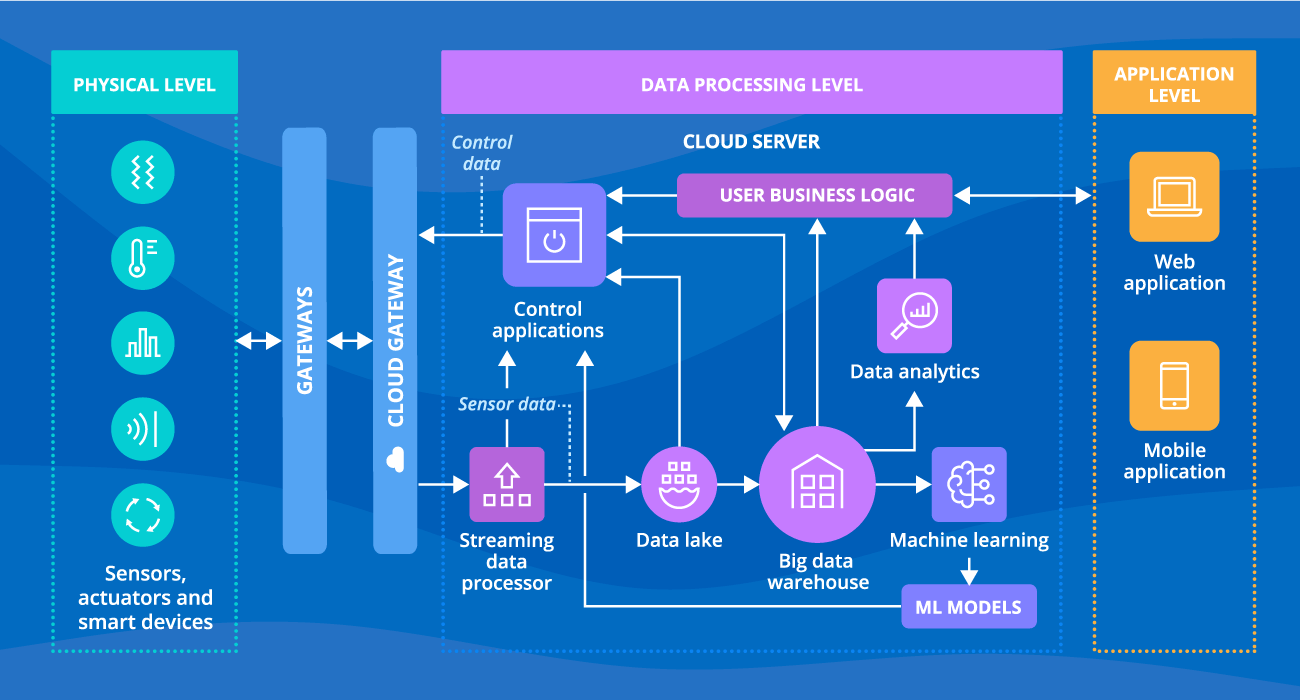
Physical level
Sensors, GPS tags and RFID tags, mounted on assets to collect and transmit various data (e.g., temperature, operating speed, location) into an IoT solution. Collected data goes through the field gateways and the cloud gateway to the streaming data processor. Actuators attached to assets receive commands to move or control them from control apps (e.g., increase or decrease machine rotation speed).
Data processing level
The streaming data processor transmits the input data to the data lake and control apps. From the data lake (where the data is stored in its natural format) it gets to the big data warehouse that stores structured data for further analysis. In-depth data analysis helps identify abnormal patterns and trends in IoT data and generate actionable insights on how to fix issues. The machine learning component creates precise models that identify data patterns and trends based on historical data. Based on these models, control applications send commands to actuators.
Application level
Web and mobile applications enable users to communicate with the IoT solution and view real-time data and reports.
The Scope of Internet of Things Development Services
IoT solution consulting
- IoT solution prototyping.
- Selection of fitting hardware (sensors, GPS tags, RFID tags (active and passive), RFID antennas, RFID readers
- Planning of automated collecting, filtering, and analyzing data from smart devices.
- Data security strategy planning.
- IoT solution adoption planning.
- IoT solution development project planning.
IoT device network creation and management
- Selection of suitable IoT devices.
- Configuring IoT devices and connecting them to the network.
- IoT devices monitoring and diagnostics.
ScienceSoft's tip: Device choice can in many ways influence the project costs and the performance levels of the final IoT solution. We pay high attention to this stage and help to balance the investments and results.
Edge computing setup
- Creating an edge infrastructure consisting of a number of edge servers placed across a network.
- Grouping IoT devices through an edge device.
- Setting up advanced analytics and reporting tools.
Data center implementation
- Designing and creating a data processing environment for heterogeneous IoT data.
- Building machine learning and data science algorithms to identify data patterns and trends that help solve specific problems in IoT-based equipment condition, operation, etc.
Development of IoT data visualization apps
- Diversity of web and mobile apps to serve IoT visualized data insights, including VR/AR apps.
- Multiple visualization techniques (e.g., bar, pie, funnel, connectivity charts; heat maps).
- Tailored reports and dashboards on IoT data for different user roles (managers, data experts, etc.).
- Customizable IoT data visualization (adding new data sources, configuring additional reports, etc.).
Development of remote control apps
- Design of rule-based and machine-learning based remote control apps (web and mobile).
- Remote control app configuration and integration with IoT devices.
ScienceSoft’s tip: We recommend ensuring that commands from control apps are additionally analyzed in the data warehouse. It helps uncover and automatically block suspicious access to control apps.
QA and testing
- Comprehensive verification of requirements for the IoT solution and its architecture.
- Well-structured and well-documented code, regular code reviews, and unit testing.
- Testing automation to increase test coverage and eliminate regression errors in the IoT solution.
IoT app management and support
- Identifying and fixing data quality, IoT application availability, and usage issues.
- Assessment of network, server, database, and application vulnerabilities, and addressing them.
- IoT infrastructure compliance review.
- Adding new functionality to IoT apps.
Why Choose ScienceSoft as Your IoT Development Company
- In software development since 1989.
- In data science since 1989.
- Delivering IoT solutions since 2011.
- Microsoft partner since 2008, AWS IoT partner, Oracle partner, and other partnerships.
- Business analysts with 5-9 years of experience.
- Full-scale PMO to handle large and complex IoT projects.
- ISO 9001-certified quality management system and project management practices to fully meet our clients' quality, time, and budget expectations regardless of any constraints.
Benefits of Cooperation with ScienceSoft
Short time to market
- Start of an IoT project in under 1 week.
- Agile development: IoT MVP in 3-6 months.
- Regular update releases every 2-4 weeks.
Assisted IoT device management
- Help with IoT hardware choice, configuration, connection, and monitoring.
- Assistance in IoT software updates.
High transparency of IoT development projects
- KPI-based progress control.
- A personalized system of KPIs for each customer (e.g., budget planned and spent, implemented features, service availability, user satisfaction).
Strong security of IoT data
- Security management capabilities are backed by ISO 27001 certificate.
- Compliance with HIPAA, GDPR, etc.
- Vulnerability assessment & penetration testing.
Pricing Models for IoT Development Projects
Fixed Price
You pay the price based on time and efforts estimated at the initial cooperation stage and specified by a contract.
Best for: IoT projects with well-defined and stable requirements: feasibility study, PoC, small and short-term IoT application development projects.
Time & Material, Time & Material with a Cap
You receive the end-of-the-month invoice based on the hours or efforts reported per month (under the stated upper limit in case of T&M with a cap).
Best for: IoT projects with a changeable scope: advisory activities, agile projects, IoT evolution, large and long-term IoT projects.
Consider Professional IoT Software Development Services
As an IoT app development company, ScienceSoft offers the following services:
IoT solution consulting
- Investigating your business context and tasks/problems you want to address with IoT implementation.
- Defining what data must be collected to meet business goals.
- Technical IoT solution requirements engineering.
- Outlining the IoT solution’s architecture.
- Determining a fitting tech stack.
- Hardware planning.
- Consulting on key integrations for the IoT solution.
- Elaborating on a data security strategy.
- Advising on the IoT solution adoption.
- IoT project planning, including time, cost and ROI estimation.
IoT solution implementation
- Eliciting technical requirements for an IoT solution.
- Designing the solution architecture.
- UI and UX design of user apps.
- Modeling a data processing environment for heterogeneous IoT data.
- Helping choose, configure, connect smart devices.
- End-to-end IoT solution development including building of control apps and user apps.
- Integration of the IoT solution with third-party software.
- Quality assurance and security testing.
- User training.
- After-launch support and evolution.
